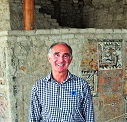


|
|
||||||||||||||||
|
|
||||||||||||||||
|
|
||
|
|
Peru El Brujo The archaeological site at El Brujo (which means witch doctor) derived its name from the fact that the site was used to perform Shamanic rituals. It is situated on the coast of Peru near Trujillo and consists of two pyramids, Huaca El Brujo (or Huaca Cortada) and Huaca Cao Viejo (or Huaca Blanca), constructed of adobe (mud bricks) by the Moche (also known as the Mochia). The Moche were hunter-gathers who inhabited the region of Northern Peru from the 1st to the 8th century and were one of the most important cultures in ancient Peru.
The site is situated on a natural terrace 17 meters above sea level with an area of 247 acres close to the seashore and contains evidence of human settlements dating back to 3000 BC. Near the complex is the ancient settlement of Huaca Prieta whilst the pyramids indicate a ritual aspect of the Moche society. The Huaca Cao Viejo consists of a platform mound approximately 100 feet tall with six levels. Its walls are decorated with brightly coloured relieves depicting geometric designs, supernatural creatures, sailing images, collections of animals, and images of sacrifice. It also includes a series of carved figures known as the ‘Warrior Narratives’ as they depict warriors in marching formation and leading prisoners to be sacrificed. At the bottom of the pyramid is a large plaza used for ceremonial purposes including the practice of human sacrifice, The site is most famous for the remains of a mummified woman known as the Lady of Cao who was found there in 2006. She is thought to be a woman aged between 25 and 30 years old at the time of her death, which is believed to have occurred between 300 to 400 AD during the process of childbirth. The lady was found buried in a grave 3 metres deep in a richly painted room in the Huaca Cao Viejo. Also buried with her were a number of other people including a teenage girl who had been sacrificed, which indicates her status as a member of Moche nobility. Wrapped in several layers of textiles, which maintained her body in a remarkable state of preservation, including her internal organs and skin – the tattoos on her skin are clearly visible. Buried with her were a number of dresses, jewellery, pottery, weapons, and other objects. All items, including the mummy, are now displayed in a museum that opened at the site in 2009, although photographs are not allowed inside. Being built of adobe the site has suffered considerable erosion over the years and work is now being undertaken not only to preserve and protect it but also to determine if the site still has any secrets to give up. To see more photographs and take a virtual tour of the site click on the photoshow below.
|
|
|
|
||
All Photographs were taken by and are copyright of Ron Gatepain
| Site Map |
